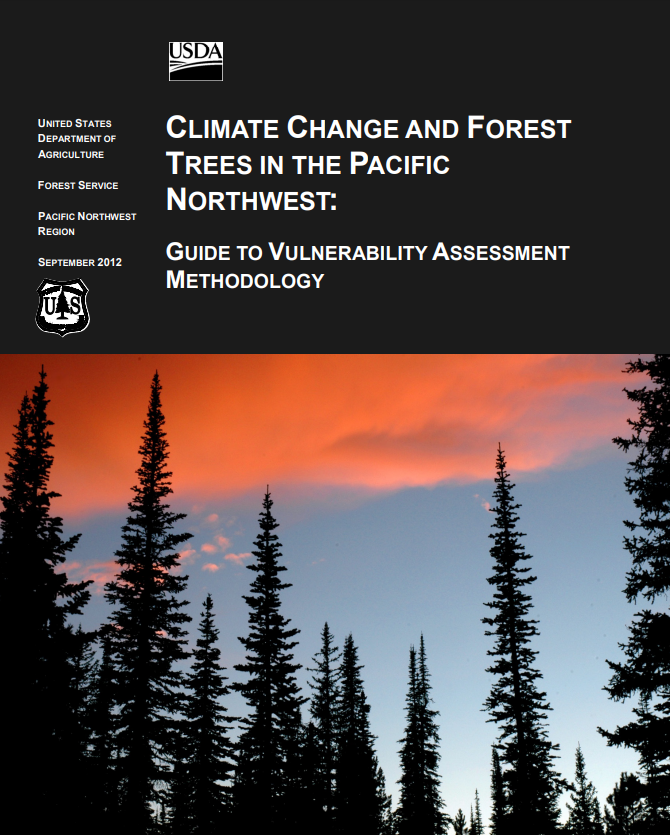Article /
Climate Change and Forest Trees in the Pacific Northwest – Guide to Vulnerability Assessment Methodology

Introduction
This resource was submitted by the Climate Risk Institute for use by the CanAdapt Climate Change Adaptation Community of Practice.
This article is an abridged version of the original text, which can be downloaded from the right-hand column. Please access the original text for more detail, research purposes, full references, or to quote text.
This guide provides a step-by-step description of the methodology used to apply the Forest Tree Genetic Risk Assessment System (ForGRAS; Potter and Crane 2010) to the tree species of the Pacific Northwest in a recent climate change vulnerability assessment (Devine et al. 2012). We describe our modified version of the ForGRAS model, and we review the model’s basic principles and operation. We also discuss further adjustments to the model that managers may find useful if applying it to other regions or to fit other objectives. Chapter 2 of this guide describes the overall methodology of the vulnerability assessment; chapters 3 through 7 describe each of the five risk factors that we selected for the Pacific Northwest vulnerability assessment. Appendices provide step-by-step procedures used to prepare the model input data.
Background: The Pacific Northwest Forest Tree Vulnerability Assessment
Climate change projections for the Pacific Northwest include year-round warming and potentially increased winter precipitation and decreased summer precipitation (Mote and Salathé 2009). The extent and duration of the regional snowpack is projected to decrease, particularly at lower elevations (Elsner et al. 2010, Mote 2003). In addition to potential direct effects of climate on individual tree vigor and survival, climate-related stress could increase vulnerability of forests to large-scale disturbance including fire and damage from insects and diseases (Dale et al. 2001). The effects of longterm climate changes on the composition and structure of Pacific Northwest plant communities are difficult to predict. There is limited information on the climatic tolerances of many species and even less information on what complex interactions could result from ecosystem-wide exposure to a changing environment.
In 2010, we launched an effort to address the projected effects of climate change on forest tree species in Washington and Oregon (Forest Service Pacific Northwest Region). We sought to determine the potential implications of climate change on the management, restoration, and conservation of forest tree species of the Pacific Northwest. The project emphasized National Forest System lands and management issues but considered the full distribution of each tree species, across all land ownerships.
This project led to the publication of a climate change vulnerability assessment focused on the forests of western Washington, with emphasis on the Olympic, Mt. Baker-Snoqualmie, and Gifford-Pinchot National Forests (Aubry et al. 2011). In 2012, we completed a regional report that included six subregional vulnerability assessments that covered all of the national forests of the Pacific Northwest Region (Devine et al. 2012) (fig. 1). Based on the results of these assessments, the reports include recommendations and specific actions for managers to address the projected effects of climate change on forest tree species in Washington and Oregon.
At the heart of the project was a vulnerability assessment—a systematic process of identifying and quantifying areas of vulnerability within a system (Glick et al. 2011). The assessment was undertaken to identify: (1) characteristics of individual forest tree species that could influence their response to long-term changes in climate, and (2) relative levels of vulnerability to climate change among tree species. This vulnerability assessment is a tool for prioritizing tree species to help managers more efficiently allocate limited resources to the most vulnerable tree species.
In contrast to some of the previously published analyses of climate change effects on forests, the Pacific Northwest forest tree vulnerability assessment was not designed to create maps of projected future suitable habitat for each species. Instead, we used documented life history traits, current distribution, and pest and pathogen data for individual tree species—combined with consensus regional climate projections—to rate each species’ relative vulnerability to a changing climate. We chose this approach because we felt that it would be most useful to managers and would provide a biological basis to assist decision-making in the near future.
After evaluating several different vulnerability assessment models, we chose ForGRAS because it is straightforward to apply, transparent, and can be easily modified to fit specific objectives and assumptions. Originally developed for the Southern Appalachian region, the ForGRAS model quantities each tree species’ climate change vulnerability, as well as the specific factors that contribute to that vulnerability (Potter and Crane 2010). The primary goal of this guide is to provide a detailed description of the methodology that we recently used (Devine et al. 2012) to apply the ForGRAS model to the tree species of the Pacific Northwest.
Citation: Devine, W.; Aubry, C.; Miller, J.; Potter, K.; Bower, A. 2012. Climate change and forest trees in the Pacific Northwest: guide to vulnerability assessment methodology. Olympia, WA: U.S. Department of Agriculture, Forest Service, Pacific Northwest Region. 49 p.
